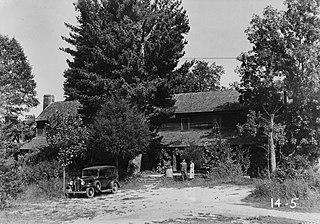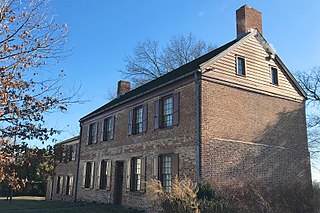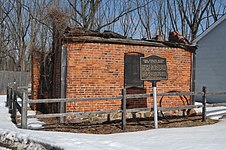
Shirley Plantation is an estate on the north bank of the James River in Charles City County, Virginia. It is located on scenic byway State Route 5, between Richmond and Williamsburg. It is the oldest active plantation in Virginia and the oldest family-owned business in North America, dating back to 1614, with operations starting in 1648. It used about 70 to 90 enslaved people at a time for forced labor including plowing the fields, cleaning, childcare, and cooking. It was added to the National Register in 1969 and declared a National Historic Landmark in 1970.

Travelers Rest State Historic Site is a state-run historic site near Toccoa, Georgia. Its centerpiece is Traveler's Rest, an early tavern and inn. It was designated a National Historic Landmark on January 29, 1964, for its architecture as a well-preserved 19th-century tavern, and for its role in the early settlement of northeastern Georgia by European Americans.

Ringwood Manor, located in Passaic County, New Jersey, was the site of an ironworks and home to a number of well-known ironmasters from the 1740s to the late 19th century. The current manor house was not built until 1807.

Skylands is a 1,119-acre (4.53 km2) estate property located in Ringwood State Park in Ringwood, New Jersey, a borough in Passaic County in the state of New Jersey. The Skylands property consists of the historic Skylands Manor mansion, The Castle at Skylands Manor and the New Jersey Botanical Garden; the botanical garden is 96 acres (390,000 m2) and it is open to the public year-round. The Skylands property is within the Ramapo Mountains and it is maintained by the Skyland Association. The property is marketed with the garden as New Jersey State Botanical Garden at Skylands.

Horton Grove was an area of houses for enslaved African-Americans at the 30,000-acre (120 km2) Bennehan-Cameron plantation complex, which included Stagville Plantation in the northeastern part of Durham County, North Carolina. The slaves who lived at Horton Grove were held by the influential Bennehan and Cameron families. In 1860, 900 total slaves were held on the complex. The several structures still standing at Horton Grove are the only two-story slave residences remaining in North Carolina.

The Wallace House is a Georgian style historic house, which served as the headquarters of General George Washington during the second Middlebrook encampment (1778–79), located at 38 Washington Place, Somerville, Somerset County, New Jersey, United States. It was added to the National Register of Historic Places on December 2, 1970.

Stagville Plantation is located in Durham County, North Carolina. With buildings constructed from the late 18th century to the mid-19th century, Stagville was part of one of the largest plantation complexes in the American South. The entire complex was owned by the Bennehan, Mantack and Cameron families; it comprised roughly 30,000 acres (120 km2) and was home to almost 900 enslaved African Americans in 1860.

The Thomas Stone National Historic Site, also known as Haberdeventure or the Thomas Stone House, is a United States National Historic Site located about 25 miles (40 km) south of Washington D.C. in Charles County, Maryland. The site was established to protect the home and property of Founding Father Thomas Stone, one of the 56 signers of the United States Declaration of Independence. His home and estate were owned by the Stone family until 1936.

Rokeby Museum is a historic farm property and museum at 4334 United States Route 7 in Ferrisburgh, Vermont. The 90-acre (36 ha) property includes a 1780s farmstead, and eight agricultural outbuildings with permanent exhibits. Hiking trails cover more than 50 acres (20 ha) of the grounds. Rokeby is open from mid-May to mid-October each year. The property was designated a National Historic Landmark in 1997 for its association with Rowland T. Robinson, a Quaker and ardent abolitionist who openly sheltered escaped slaves at Rokeby as part of the Underground Railroad. Robinson's extensive correspondence is an essential archive giving insight into the practices of abolitionists and the operations of the railroad.

Hope Plantation, built in 1803, is an early house built in the Palladian mode of the federal style, located on the Carolina Coastal Plain, near Windsor, North Carolina, in the United States. The plantation house was built by David Stone, a member of the coastal Carolina planter class, later Governor of North Carolina and a United States senator. One of the finest examples of Palladian design built in timber, the manor house is slightly modified by neo-classical elements. The facade has five bays and a pedimented double portico with the original Chinese Chippendale balustrade. Crowning the house is a widow's walk with matching railing. The interior of the house displays a height and grandeur rare in the region, and is furnished with a unique collection of period furniture, art and artifacts.

Burleigh, or Burleigh Manor, or Hammonds Inheritance is a historic home located at Ellicott City, Howard County, Maryland, built on a 2,300-acre (930 ha) estate. Which included "Hammonds Inheritance" patented in 1796. It is a Federal-style brick dwelling built between 1797 and 1810, laid in Flemish bond. Based on the 1798 Tax assessment of the Elkridge Hundred, the original manor house started as a one-story frame building 24 by 18 foot in size. Also on the landscaped grounds are a 1720 stone smokehouse; a much-altered log, stone, and frame "gatehouse" or "cottage," built in 1820 as a workhouse for slaves and another log outbuilding, as well as an early-20th century bathhouse, 1941 swimming pool, and tennis court. Portions of the estate once included the old Annapolis Road which served the property until the construction of Centennial Lane to connect Clarksville to Ellicott City in 1876. The manor was built by Colonel Rezin Hammond (1745–1809), using the same craftsmen as his brother Mathias Hammond's Hammond–Harwood House in Annapolis. Rezin and his brother Matthias were active in the colonial revolution with notable participation in the burning of the Peggy Stewart (ship). Hammond bequeathed the manor and 4,500 acres (1,800 ha) to his grandnephew Denton Hammond (1785–1813) and his wife Sara who lived there until her death in 1832. All slave labor were offered manumission upon Rezin Hammonds death in 1809, with extra provisions for tools, land and livestock for thirty two slaves. The estate was owned by Civil War veteran Colonel Mathias until his death where he was buried alongside other family members on the estate. His wife Clara Stockdale Hammond maintained ownership afterward. In 1914 the estate was owned by Mary Hanson Hammond with land totaling over 1,000 acres (400 ha) including the outbuildings and slave quarters. In 1935 the Estate was subdivided to 600 acres (240 ha) and purchased by Charles McAlpin Pyle, Grandson of industrialist David Hunter McAlpin. The manor house was renovated with the great kitchen replaced by a "Stirrup Room" where meetings of the Howard County Hunt Club were performed. The house was sold in 1941 to Mrs. Anthony J. Drexel Biddle, Jr. for use of Prince Alexandre Hohenlohoe of Poland during WWII. St. Timothy's School bought the property after the war in 1946, but abandoned plans and sold to Mrs G. Dudley Iverson IV in 1950. The brick was once painted yellow, but by 1956, had almost returned to exposed red brick. As of 2013, it has operated as a livestock shelter.
Woburn Manor is a historic home and farm located near Sharpsburg, Washington County, Maryland, United States. The manor house is a Federal style, 2+1⁄2-story stuccoed stone dwelling with a gable roof structure built around 1820. The stucco is incised to resemble cut block. The property includes a landscaped yard with terracing to the south, stone outbuildings including an out kitchen and smokehouse, and slave quarters.

The Jacobus Vanderveer House, also known as Knox House, is a U.S. Federal style house located just north of the community of Pluckemin in Bedminster Township, Somerset County, New Jersey at the junction of US 202 and 206 north of River Road. The house was added to the National Register of Historic Places on September 29, 1995, and noted as an "excellent example of a Dutch–American house". The Vanderveer /Knox House & Museum while owned by Bedminster Township, is operated under the direction of the Friends of the Jacobus Vanderveer House, a 501-C3 non-profit organization. The Jacobus Vanderveer House is situated on part of the 218 acres (0.88 km2) that make up River Road Park. The house was thought to be built somewhere in the mid-1770s by James (Jacobus) Vanderveer, son to Jacobus Vanderveer after the property was willed to him by his father.

Shippen Manor is located in Oxford Township, Warren County, New Jersey, United States. The manor was built in 1755 and was added to the National Register of Historic Places on December 20, 1984. It was later added as a contributing property to the Oxford Industrial Historic District on August 27, 1992.

The Peter Huyler House is located on what is known as the Captain John Huyler Homestead at 50 County Road between Palisades Avenue and Crest Drive North in Cresskill, Bergen County, New Jersey. In 1776, the property was part of a 180-acre (73 ha) farm which belonged to Loyalist John Ackerson or Eckerson. It was confiscated in 1779 because of Ackerson's loyalty to the British, and sold in 1784 to Captain John Huyler of the local militia. Huyler's son Peter built the main wing of the current house in 1836, according to the date stone over the door, with what was described by the Bergen County Stone House Survey as "some of the finest stonework in Bergen County". The outbuilding was most probably a summer kitchen, with quarters for slaves.

Westend is a temple-fronted house near Trevilians, Virginia, United States. Built in 1849, the house's design refers to the Classical Revival style, representing an extension of the Jeffersonian ideal of classical architecture. The house was built for Mrs. Susan Dabney Morris Watson on a property that she had inherited from her late husband. The building project was supervised by Colonel James Magruder. The house was the centerpiece of a substantial plantation, and a number of dependencies, including slave dwellings, survive. Westend remains in the ownership of the descendants of Mrs. Watson.

Blandy Experimental Farm Historic District is a national historic district located adjacent to The Tuleyries at Boyce, Clarke County, Virginia. It encompasses 15 contributing buildings, 1 contributing site, and 1 contributing structure. They include a large, two-story, brick slave's quarters built about 1825; a stone and brick stables that was later converted into a dwelling; a turn-of-the-20th-century farmhouse and its associated agricultural and domestic related outbuildings; a late-19th century vernacular hall-parlor-plan house; two historic dwelling sites; as well as orchards and fields of improved pasture.

The Staats House, also known as the General Baron von Steuben Headquarters, is a historic building located at 17 Von Steuben Lane in South Bound Brook, Somerset County, New Jersey. Constructed c. 1740, it is now known as the Abraham Staats House after its second owner. In 1779, during the second Middlebrook encampment of the American Revolutionary War, it served as the headquarters for Prussian-American General Friedrich Wilhelm von Steuben. The house was added to the National Register of Historic Places on December 4, 2002, and noted as representing "one of the finest remaining buildings from the second phase of Dutch immigration and settlement in the Raritan Valley".

The Van Veghten House is a historic building in the Finderne section of Bridgewater Township, New Jersey. It was built around 1725 and served as the headquarters of Quartermaster General Nathanael Greene during the second Middlebrook encampment (1778–79) in the American Revolutionary War. The Somerset County Historical Society owns the house and uses it as its headquarters, including a museum and library. The early 18th-century Old York Road passed by here connecting Philadelphia to New York City. The house was added to the National Register of Historic Places on October 10, 1979 and noted as representing "one of the few remaining Raritan River mansions".

The Van Horne House is a historic building at 941 East Main Street near Bound Brook in Bridgewater Township, Somerset County, New Jersey. The house was built c. 1750 and also known as Phil's Hill, after its owner, Philip Van Horne. It served as the headquarters for American General Benjamin Lincoln in 1777, during the American Revolutionary War, in particular the Battle of Bound Brook. Later, it served as the headquarters for American General William Alexander, Lord Stirling during the second Middlebrook encampment (1778–79). The house, on the early-18th-century Old York Road that connected Philadelphia to New York City, was a New Jersey landmark during the war. Since 2002, the Heritage Trail Association has used the house as its headquarters, including an exhibit space. It was added to the National Register of Historic Places on March 8, 2002, for its locally significant Colonial Revival architecture from 1937 to 1944.
























